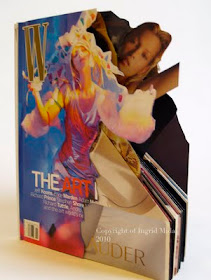 |
Angela Chen F/W 2011
Photo by George Pimmentel |
When I saw Canadian fashion designer's
Angela Chen's Fall-Winter 2011 presentation at
LG Fashion Week, I was struck by her bold combination of chunky knitwear with delicate fabrics like tulle. It was paradoxically cozy and delicate at the same time and reminded me of ballerina dancers in rehearsal with their sweaters and knitwear piled on for warmth.
It was this successful pairing of hard and soft elements that led me to seek out an interview with Angela.
Ingrid: It seems to me that you took bigger risks with this collection in moving beyond classical elements into more daring and bolder design work. Would that be an accurate assessment?
Angela: Yes. This season I was really inspired by contemporary artist Jonathan Lasker and his brushstroke technique. Jonathan likes to play with form and this influenced my decision to knit. With knits I can incorporate both thick and thin yarns to create unique shapes that are heavily texturized. My collection captures bright white against black to achieve a bold contrast similar to Jonathan’s use of pop colours against neutral backdrops. I love his artistic technique and his ability to use erratic brush strokes to play with shape. I drew on his use of repetition and freehanded lines when I knit my Fall collection. This season my collection is titled Sleep & Poetry, which is also a partial title of a Lasker book of drawings and poems, and a poem by John Keats.
Ingrid: Almost all the pieces in this collection seem to have a knitwear element. Was this a conscious decision to move to focus your strengths and something that you enjoy?
Angela:
Knitting has become one of my signature styles. I love the art of knitting because it allows me to manipulate yarn so I can play with different silhouettes, create repetition and weave abstract lines, similar to what Jonathan is able to accomplish with his sporadic brushstrokes and use of abstract forms in his artwork.
 |
Angela Chen FW Collection 2011
Photo by George Pimmentel |
Ingrid: How did you begin your design process for this particular collection? Did you sketch it out first or just pick up the knitting needles?
Angela: I knew that I wanted to incorporate a lot of knits into my FW2011 collection. I sketched dozens of knitwear ideas down on paper before I picked up the knitting needles. When it came time to pick up the knitting needles I didn’t put them down until right before the show!
Ingrid: I was particularly drawn to your tulle skirts. Is this the first time you've worked with tulle?
Angela: This was my first time incorporating tulle tutus into a collection. I decided to use tulle because I enjoyed how the chunky knit mixed with the tulle to create a hard and soft contrast, similar to Jonathan’s paintings. Tulle and yarn allowed me to create texturized layers and shapes, which is why I incorporated them both into my collection. Jonathan really inspired me to play with form and contrast. The wool yarn I used had hints of mohair in it, which is a light-weight yarn; my outfits had to appear big and chunky but be light enough to wear and I think incorporating the tulle skirts emphasizes the weightlessness of the collection.
Ingrid: In our previous interview, you mentioned that you hand-knit all the chunky sweaters yourself. Was that also true this time? If so, how do you envision this going into production?
Angela: It’s true! All the knits in my FW2011 collection were hand-knit by me. For the production of my knitwear I contacted a fashion office in Hong Kong that connected me to a factory in Shenzhen that specializes in knits. While most of my production is based in Vancouver, Shenzhen handles my knitwear pieces. I believe that building connections overseas is the first step in establishing OR as a global brand.
 |
Angela Chen FW 2011
Photo by George Pimmentel |
Ingrid:
Almost all the pieces were in black and white, except perhaps for the tulle skirt and the purple bustier. Why weren't they also in black or white? (I loved them in gold but just found it interesting that they weren't black or white).Angela: I choose gold because I wanted to incorporate a pop of colour within my collection. I was influenced by Jonathan’s use of bright colours against a neutral backdrop in his paintings. Also, it is important for me to create a collection that is timeless; I chose to incorporate gold within my colour palette because gold will never go out of style.
Ingrid: Please update me on where you are selling your collection now.
Angela:
I am currently in talks with some stores in Toronto which I am very excited about. I also have OR selling in British Columbia and in Taiwan. Online my line is available at Moxsie Online Boutique and Etsy.
Ingrid: What's next?
Angela: I would like to open a flagship OR by Angela Chen store in countries all over the world, starting with Canada of course!
 |
Angela Chen at LG Fashion Week 2011
Photo by George Pimmentel |
Photos provided courtesy of Angela Chen via lotus leaf communications























